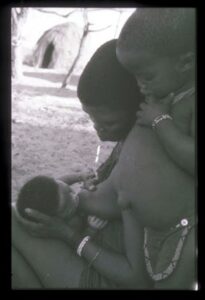

What is the architecture of the sibling kin detection system?
Which emotional and motivational programs does this system regulate?
The Architecture of Human Kin Detection by Debra Lieberman, John Tooby, & Leda Cosmides. In the February 15, 2007 issue of Nature, vol. 445, 727-731.
Nature podcast, Interview with Debra Lieberman; Nature’s Making the paper: John Tooby
Scientists at the Center for Evolutionary Psychology have been developing a computational approach to motivation, as one part of their NIH Director’s Pioneer Award project. “The architecture of human kin detection”, by Debra Lieberman, John Tooby, and Leda Cosmides, is one example of this new approach. This article, which appeared in the February 15, 2007 issue of Nature, provides evidence that the mind unconsciously computes an internal regulatory variable—a kinship index—that tracks the genetic relatedness of siblings, and that this variable in turn regulates altruism toward siblings, aversion to sibling incest, and support for moral norms prohibiting incest.
The issues: Humans in all known cultures feel differently about family members than they do about non-family members. To greater or lesser degrees, they are willing to sacrifice some of their own welfare to help family members, and they feel usually disgusted at the prospect of having sexual contact with nuclear family members (those who are genetic relatives). They also often feel incest to be morally wrong, and generally oppose brother-sister and parent-offspring incest in others.
What causes these phenomena, and what previously unknown facts about the human mind/brain can be discovered by using them as the basis of a research program?
Our expectation as evolutionary psychologists, along with other Darwinians, is that humans evolved their neural and physical design because natural selection favored the spread of some design features over others across evolutionary time. Among our ancestors, some genetically inheritable design features caused their own increase in frequency, until now they are universal features of our species. Most evolutionary scientists, like us, have long suspected that these patterned family sentiments in humans are the product of natural selection, because well-validated theories in evolutionary biology provide an explanation for why humans should have evolved to be this way (see below). This view has been controversial. Skepticism was perhaps reasonable because the evidence for an evolved neural program designed to cause these effects was scattered and highly indirect. Moreover, no one knew what the architecture of such a system looked like, what turned the system off and on, and what caused patterned differences among individuals in family sentiments.
Why do humans have these particular sentiments toward family members, rather than others?
Evolutionary researchers usually expect that organized, species-typical characteristics evolved because they are functional–that is, they solved adaptive problems for the organism. What adaptive problems do these motivational outputs toward family members seem designed to solve? Evolutionary biologists have found that genetic relatedness plays an important role in shaping the social behavior of thousands of species. In fact, genetic relatedness posed two entirely different adaptive problems for humans and our foraging ancestors. (We think the mechanism described in this paper is the evolved solution to these problems.)First, close inbreeding damages offspring (especially incest among nucler family members). This is because we all have deleterious recessive genes arising from mutation, and inbreeding increases the probability that the offspring conceived will have two copies of the same defective genes. When this happens, the child is more likely to either die in utero or be born with congenital abnormalities. So imagine a design feature—a neural circuit—motivating one to have sex with close genetic relatives: it would find itself in fewer bodies, many of which were differentially handicapped. As a result, genes coding for designs motivating incestuous sex would, over time, cause their own disappearance—they would be eliminated from the population by natural selection. In contrast, imagine an alternative design feature—a different neural circuit—that creates a motivation to avoid sex with genetic relatives: it would find itself in more bodies, and these bodies would be healthier than those produced by incestuous sex. As a result, design features motivating one to avoid sex with close genetic relatives would promote their own reproduction–they would spread through the population by natural selection, until we all have them. In consequence, we should expect natural selection to produce motivational systems that make us want to avoid sex with close genetic relatives.
Second, kin selection theory, perhaps the single most important theoretical advance in evolutionary biology since Darwin, predicts that natural selection should have created motivational systems that make us more willing to help our close genetic relatives than unrelated people (all else equal). Imagine a design change that motivates an individual to help his or her relatives so that they reproduce more effectively. There is some probability, r, that a kin member who receives this help has inherited that very same design change from a common ancestor. This means the design change—through causing assistance to the relative in a way that ultimately increases the likelihood that they will have enhaced reproduction—will spread new copies of itself in the population (provided it does not decrease the individual’s own reproduction too much).
George and Doris Williams (1957) first advanced this general argument that sibling altruism (for example in the social insects) was explained by genetic relatedness. W.D. Hamilton (1964) formalized and generalized this result to all genetic relatives, showing that a new altruistic design can spread through the population if it causes an individual to help a kin member whenever the cost to the individual’s own reproduction is offset by the benefit to the reproduction of its kin member, discounted by the probaiblity, r, that the kin member has inherited the same helping design. r is called their degree of relatedness, and it expresses the probability that two individuals share a given gene by virtue of inheriting it from a recent common ancestor. (Because it is the 50th anniversary of George and Doris Williams’ seminal paper first linking sibling altruism to genetic relatedness, our paper is dedicated to them.)
This is why biologists and evolutionary psychologists predict that natural selection should have constructed brain mechanisms in humans that motivate altruism towards close genetic relatives, as well as brain mechanism that motivate us to avoid having potentially conceptive sex with close genetic relatives.
The problem of determining genetic relatedness
Solving each of these two different adaptive problems (aiding kin, avoiding ncest) requires the solution to a third adaptive problem: identifying who is and who is not a genetic relative, and estimating how close a genetic relative a familiar other is likely to be.
Detecting relatedness is therefore a major adaptive problem, and not an easy one to solve. There is no way for us or our ancestors to directly “see” another person’s DNA directly and compare it to our own, in order to determine genetic relatedness.
This led us to the prediction that natural selection solved this problem for both motivational systems by equipping our brains with a single unitary kin detection system. It was predicted to compute an internal index of relatedness, and to do so by incorporating circuits designed to monitor indirect cues that were useful because they were reliably correlated with genetic relatedness over recent human evolutionary history. It then outputs this information to two different motivational systems: one for motivating sexual aversion / attraction, the other motivating family-directed altruism. By considering the information about genetic relatedness that was built into the structure of hunter-gatherer life, we predicted that the architecture would use two independent cues as the source of its information about relatedness: maternal perinatal association, and duration of coresidence during the period of parental investment. We do not rule out the possibility that other cues may be found.
Olders detecting younger sibs. As mammals, human mothers nurse and care for their newborn infants, so seeing your own mother care for a newborn is a reliable cue that this baby is your sibling. Our data show that if you are older, and are present in the home when your biological mother is caring for a new baby, the mind tags that baby as a sibling—leading to high levels of altruism and sexual aversion toward that particular younger sibling, regardless of how long the two of you subsequently co-reside in the same household. We call this the maternal perinatal association cue, or MPA.
Youngers detecting older sibs. But if you are younger, this MPA cue won’t work, because your older sibling was born before you. So to detect older siblings, the mind defaults to a different cue: how long you co-resided with this child during the period of parental investment, approximately between ages 0-18. In 1891, Edward Westermarck, the Finnish Darwinian sociologist proposed that early childhood coresidence caused sexual disinterest between siblings. Pioneering archival studies by Arthur Wolf and others provided support for this view, by showing that the fertility rates were lower and divorce rates higher among Chinese marriages involving non-siblings raised together from childhood. However, based on a functional analysis of the information provided by the socioecology of hunter-gatherers, we predicted that the monitoring system should look not only at early childhood, but at the entire period of parental investment. Indeed, hunter-gatherer bands are composed of several nuclear and extended families; as conditions change, these bands fission into smaller groups and later fuse back together again. But when they fission, they do so along nuclear family lines, with children staying with parents (especially mothers). Under such conditions, the more time you log with a child while growing up, the more closely related to you that individual is likely to be. We find that duration of childhood coresidence is still highly correlated (r = ~.70) with degree of kinship (i.e., full, half, or step siblinghood), even among the subjects in our study.
Cue integration by the Kinship Estimator. It takes 14-16 years of coresidence to produce levels of altruism and sexual aversion toward older siblings that are as high as those produced by the MPA cue, that is, by being there when your younger sib was being cared for by your mother. (For lovely graphs showing this, see Figure S1 in the supplementary information for our article). The MPA cue and duration of coresidence cue are not additive: that is, olders do not have higher levels of altruism and sexual aversion toward a younger sibling when they are exposed to the MPA cue AND coresided with that sibling for a long time. If the MPA cue is present, levels of altruism and sexual aversion toward that sibling are high, and coresidence duration does not matter; coresidence duration matters only when the MPA cue is absent.
This means the two cues are not being fed directly into the motivational systems. Instead, there is a mechanism that is combining them, in a non-additive way, to compute a kinship index (and this kinship index is being fed into the motivational systems regulating sexual aversion and altruism). If cues are being combined, then there must be a mechanism that is doing the combining. We refer to this mechanism as the kinship estimator, and the data indicate that it employs an algorithm that combines the cues in a noncompensatory way (as in a decision tree).
Nonconscious computation. The kinship estimator seems to compute kinship indexes nonconsciously, and independent of your conscious beliefs. A striking example of this involves siblings who are step or adoptive–that is, siblings who the subject knows are not genetically related. Duration of coresidence predicts altruism and sexual aversion toward step and adoptive sibligns. This shows that when conscious beliefs conflict with the output of the kin detection system, the criteria used by the kin detection system prevail.
Freud, cultural determinists, and socialization theories got it wrong. Freud thought that we are born with a strong primary erotic attraction to our parents and siblings. Our research indicates that natural selection built mechanisms with the specific function of rendering kinship anti-erotic, an attitude widely expressed across cultures. Once the kin detection system has tagged someone (rightly or wrongly) as a sibling based on the MPA and coresidence cues, the thought of sex with that person elicits disgust. The situation for youngers detecting olders is particularly probative with respect to socialization theories: Even though the same cultural taboos are present for everyone, youngers who have spent less time co-residing with an older sibling feel less disgust at the thought of incestuous sex with that sibling than do youngers who have coresided with their older sibling for a long time. Duration of co-residence also predicts their moral wrongness judgments: youngers find (consensual) brother-sister incest between third parties more morally wrong the longer they have co-resided with their older sibling.
Why might a small minority of individuals still be inclined to engage in incest?
Although our data are statistical, and cannot speak strongly to individual cases, it seems likely that there are two primary explanations.
First, our data indicate that sexual aversions are triggered by exposure to cues of genetic relatedness: seeing one’s biological mother caring for an infant (MPA cue), or living in the same household with a child for most of one’s own childhood (coresidence duration cue). If an individual has not been exposed to either of these cues, then the sexual aversion will not be triggered. This means that individuals may be more incestuously inclined when their upbringing has disrupted their exposure to these cues of kinship: regardless of their conscious beliefs, the brain mechanism that detects siblings will not have tagged that person as a sibling. The results in such cases may be tragic, but they do not stem from a malfunctioning of the brain.
The second explanation involves malfunction. Like every other system in the brain and body, the kin detection system can malfunction (i.e., be broken). It can fail to develop; it can be damaged by stroke, injury or exposure to pathogens; its normal functioning can be disrupted by alcohol or drugs. Any ordered system can be damaged or disordered. When this happens, the motivational system causing erotic attraction will not be turned off by cues of kinship.
For earlier work on cues used during development by the kin detection system to identify siblings, see:
Lieberman, D., Tooby, J. & Cosmides, L. (2003). Does morality have a biological basis? An empirical test of the factors governing moral sentiments relating to incest. Proceedings of the Royal Society London (Biological Sciences), 270(1517), 819-826. PDF






